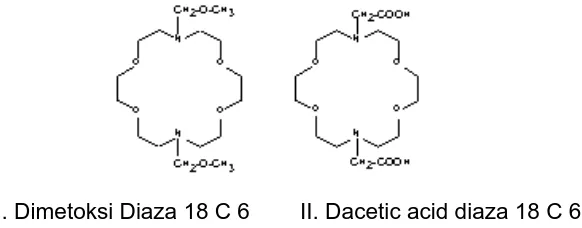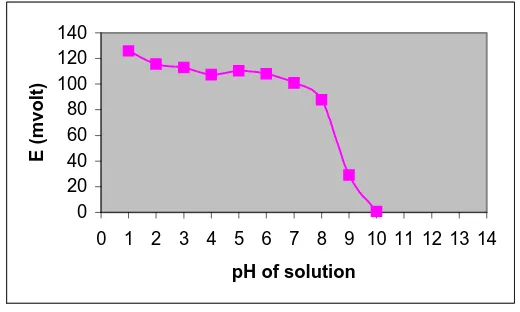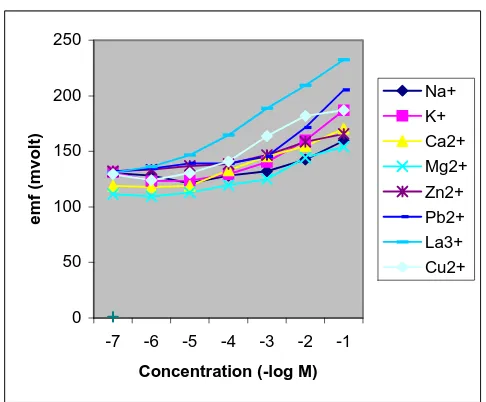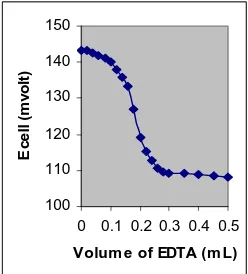LANTHANUM (III) SELECTIVE ELECTRODE BASE 1,10-DIAZA-4,7,13,16-TETRAOXACYCLOOCTADECANE-N,N’-DIACETIC ACID AS IONOPHORE
Suyanta a,*,
a) Departement of Chemistry, Yogyakarta State University, Yogyakarta
Abstract
Lanthanum (III) ion selective electrode base on an ionophore 1,10-Diaza-4,7,13,16-tetraoxacyclooctadecane-N,N’-diaceticacid was studied. Electrode was prepared with inner solution system by the membrane composition containing active ionophore, anionicside KTCPB, plasticizer NPOE and support matrix PVC. A good response is obtained with slope 19,93 ± 1,62 and electrode can response with detection limit 5.10-6 M. Measurement range is wide (10-5 – 10-1 M) and has response time about 27 seconds. The electrode can measure lanthanum ion with a few interfering alkali, earth alkali and transition element.
Keywords: Lanthanum ion-selective-electrode, PVC membrane,
1,10-Diaza-4,7,13,16-tetraoxacyclooctadecane-N,N’-diaceticacid
*) Corresponding : author : Phone: 0274-492506 / 0274-586168-psw-271 Email : [email protected]
1. INTRODUCTION
Rare earth elements is known as important inorganic compound, because its properties, especially its strong magnetic materials. One of the important element is lanthanum. The available methods for low level determination of rare earth ion in solution includes, ICPMS, ICPAES, X-ray fluorescence spectrometry, etc.1-2 These methods are either time consuming, involving multiple sample manipulation and too expensive for most analytical laboratories.
Ion selective electrode (ISE) in potentiometry is one of method analysis that more simple and unexpensive but can used as a good methods. Ion selective electrode with neutral carrier was developed for some element especially for alkali, earth alkali and transition element.3 There are as successful method for analysis. For rare earth element, the system is very little do it some researcher. Only a few report are found in the literature on preparation ore rare earth ion selective electrode.4 For the reason, we try to do the ion selective electrode for rare earth element, especially for the lanthanum element.
Macrocycle compound has properties to construct complex compound with some metals. In this case macrocycle function as a ligand.5 For example, crown ether with alkali and earth alkali metals ion that very specific complex compound. Macrocycle with N (nitrogen) element usually make complex compound with transition elements. Chang C.A. was synthesis macrocycle compound lariat diaza 18 C 6 (1,10-Diaza-4,7,13,16-tetraoxacyclooctadecane-N,N’-diaceticacid and 1,7-Diaza-4,10,13-trioxacyclooctadecane-N,N’-diaceticacid) and study complexation with rare earth element. They conclusion are that compound as selective reagents for lanthanides ion.6 For this reason we try to make ion selective electrode for lanthanum element with compound lariat diaza 18 C 6. We vocused with two kind of macrocycle compound that structure can see in the figure 1.7
I. Dimetoksi Diaza 18 C 6 II. Dacetic acid diaza 18 C 6
2. THEORY
Ion selective electrode membranes are typically investigated under zero current conditions an a galvanic cell. With the outer reference calomel electrode and inner reference Ag/AgCl electrode, the cell construction is :
Hg/Hg2Cl2/KCl(sat): 3 M KCl ∶∶ Sample solution ∥ membrane ∥internal filling solution / AgCl/Ag
The electromotive force (emf) a cross this cell is the sum of all individual potential contributions. From the example cell, the emf is measured as equation: 8
Emf = Econst + Ej + Em ………. 1 Where Em is the membrane potential and Ej is the liquid junction potential at the sample / bridge electrolyte interface, which can either be kept reasonably small and constant under well defined condition or be estimated according to the Henderson formalism.9 So value emf only estimated with membrane potential.
Membrane is usually interposed between the sample and an inner reference electrolyte. It is common to divide the membrane potential (Em) into three separate potential contributions, namely the phase boundary potential (EPB) at both interfaces and the diffusion potential (EDiff) within the ion selective membrane.
Em = EDiff + 2 EPB ……… 2 For ion selective electrode, the membrane internal diffusion potential is zero if no ion concentration gradients occur. The concentration ion in the inner solution are constant, so potential boundary in inner interface is constant. From the assumption value Em is:
Em = EConst + EPB ……… 3 Where EPB is the phase boundary potential at the membrane sample interface.
Value of boundary potential can be derived from basic thermodynamic consideration. First, the electrochemical potential, (µe) , is formulated for the aqueous
phase.8-11 From the membrane system we can separate two kind phase. There are water phase and organic phase. If the electrochemical potential in the water phase as:
µ
e (aq) =µ
(aq) + zFØ (aq)=
µ
o(aq) + RT ln ai (aq) + zFØ (aq) ... 4 So at the same condition, electrochemical potential at the organic phase is:
=
µ
o(o) + RT ln ai (o) + zFØ (o) ... 5 Where
µ
is chemical potential (µ
o = standard chemical potential), z , ion valence ; ai activity of free ion i; Ø, electric potential, and R, T, F are general gas constant, absolute temperature and Faraday constant.If was assumed that ion transfer and complexes reaction at interphase very fast and happened equilibrium equation, so the chemical potential at two phase will be equal. We can construct boundary phase potential as dispute of electrical potential at two phase.
From the equation 3 and 6, we can formulate the membrane potential as follow:
µ
o(o) -
µ
o(aq) RT RT
Em = EKonstan - --- - --- ln ai (o) + --- ln ai (aq) ... 7 ZF zF zF
If the value of ion activity in organic phese ai (org) is constant and other variable is constant, so equation will be follow:
RT
Em = Eo + --- ln ai (aq) ... 8 zF
This equation is call as Nernst equation. From the equation we can look that membrane potential only idetical with a number analyt ion activity.
3. EXPERIMENTAL Reagent
Membrane and Electrode Preparation
The membranes solution was prepare by dissolving 10.0 mg 1,10-Diaza-4,7,13,16-tetraoxacyclooctadecane-N,N’-diaceticacid, 45 mg PVC, 90 mg NPOE and 5 mg KTCPB in 3 mL of THF. The solution was evaporated on the glass with square 1,5 x 4 cm2. Electrode was prepared by glued tube electrode to the membrane. Inner electrode reference Ag/AgCl and inner solution (mixture KCl 10-3 M and La3+ 10-3 M) is set in the tube and connected to cable. The electrode was conditioned before potentiometry measurement by immersing it in 10-3 M LaCl3 solution for 24 hour.
Electrode System and EMF Measurement
Cell configuration used for potentiometry measurement were of the type:
Hg/Hg2Cl2/KCl(sat): 3 M KCl ∶∶ Sample solution ∥ membrane ∥internal filling solution / AgCl/Ag
EMF measurement were carried out with calomel electrode (ORION) coupled with ORION pH/Ion-meter 420A. The concentration of lanthanum (III) ion in the sample solution was varied from 10-1 to 10-8 M in stirred solution. The EMF value were recorded when the reading ion-meter became stable. The pH value of the sample solution were adjusted with NaOH and HCl/HNO3 and measured with pH-meter. The activity of metals ion were based on their activity coefficient, γ , as calculated from the modified Debye Huckel equation:
Log γ = - 0,511 Z2 [ √µ / (1+1,5 √µ) ) - 0,2 µ ]
Where µ is ionic strength and Z is valence of the concerned ion. All the EMF measurement we performed at 25 ± 3 oC.
4. RESULTS AND DISCUSSION
Response characteristic of La(III)-selective electrode
Table 1. Composition of membrane electrode and Nernstian response
From the data, it can saw that the composition with 6,87 % ionophore DACDA and 3,57 KTCPB give a Nernstian response with slope 19.93 mV/decade.
Effect pH to the potential response
We make the series of solution of La3+ with the pH from 1 to 10, by added HCl and NaOH solution. Potential solution is measured by the cell system and the result can see in the figure 2.
0
Figure 2: Effect pH to the potential response
From the figure that pH relatively constant at pH 3 to 7. The pH dropped at 8 to 10, this is because the lanthanum ion was precipitated to form hydroxide metal. So, we will work at pH 4.5.
Effect of macrocycle lariat compound
(ionophore 2). The capability of the electrode can see with response potential in figure 3.
100 120 140 160 180 200 220 240
-9 -8 -7 -6 -5 -4 -3 -2 -1 0
- Log Concentration (M)
E (mVolt)
Ionophor 1 Ionophor 2
Figure 3: Characteristic response potential electrode of two kind compound ionophore.
From the figure we can see that electrode with ionophore 1 has a good response than electrode with ionophore 2. Detection limit electrode with ionophore 1 is better than ionophore 2. Range measurement electrode 1 is more widely than electrode 2 (electrode 1: 10-5 – 10-1 and electrode 2: 10-5 – 10-2 M). The electrode can response analogue about 30 second and has life time about 2 month.
Selectivity of electrode
0
Figure 4: Potential response of La-ISE to ion La3+ and others
From the data in figure 4, the value KAPot,B is calculated with MPM system. The result for all ion interference can see in table 2.
Tale 2: Selectivity coefficient of various interfering ion*
Mn+ Pot
As seen, for ions alkali, earth alkali and some transition ions have selectivity coefficient value in the order 10-3 – 10-2. These is indicating that they do not disturb the function of La-ISE. But for the rare earth ion, they are relatively disturb for measurement of ion La3+. Otherwise this electrode can measure total rare earth ion in the sample.
Application
two method are produce the same result. Application in potentiometry titration with ESI-La as working electrode is do it. The result of titration can see in figure 5.
100
Figure 5: Potentiometry titration 25 mL 10-5 M La3+ with 5.10-3 M EDTA by ESI-lanthanum
Table 2: Result of analysis La3+ in sample with methods ISE and ICP-AES Number
REFERENCE
1. Houk, R.S., Fassel, F.A., Flesch, G.D., Svec H.J., (1980), Inductively coupled argon plasma as an ion source for mas spectrometric determination of trace element, Analytical Chemistry, 52, 2283-2289.
2. Anonim, (1988), Analytical methode for Atomic Absorption Spectrophotometer, AA100, New York: Perkin Elmer.
3. Masuda A., Nomura N., Tanaka T., (1973), Geochim Cosmochim Acta, 37, 239-245.
4. Morf WE., Simon W., (1978), Ion Selective Electrode in Analytical Chemistry, Freiser H Ed, Plenum, New York.
5. Choudhury DA., Obata T. and Kamato S., (1996) Samarium (III) selective electrodes using neutral bis (thiaalkylxanthato)alkanes, Anal Chem, 68, 366-378.
6. Zolotov Xu A., (1997), Macrocyclic Compound an Analytical Chemistry, John Willey and Sons Inc, New York.
7. Chang CA., Ochaya Ven O., (1986), Inorg Chem, 25, 355-358.
8. Fabre B., Simonet J: Coordination Chemistry Reviews, 1998, 178-180, 1211-1250.
9. Bakker E., Bulhman P., Pretch E., (1997), Carrier based ion selective electrodes and bulk optodes, ionophores for potentiometric and optical sensors, Chem Rev, 3083-3132.
10.Gadzeppo VP., Christian GD., (1984), Determination of selectivity coefficients of ion selective electrodes by a matched-potential-method, Anal Chim Acta, 64, 279.
11.Umezawa Y., Umezawa K., Sato H., (1995), Selectivity coefficients for ion selective electrode: recommended methods for reporting KAB value, Pure Appl Chem, 67, 507.




